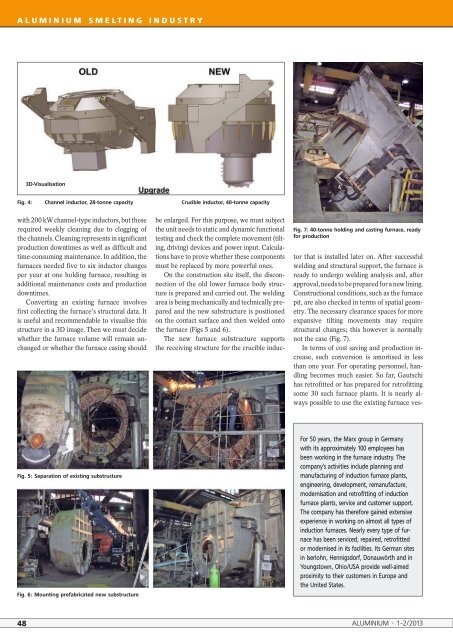special - ALUMINIUM-Nachrichten – ALU-WEB.DE
special - ALUMINIUM-Nachrichten – ALU-WEB.DE
special - ALUMINIUM-Nachrichten – ALU-WEB.DE
Create successful ePaper yourself
Turn your PDF publications into a flip-book with our unique Google optimized e-Paper software.
<strong><strong>ALU</strong>MINIUM</strong> SMELTING INDUSTRY<br />
3D-Visualisation<br />
Fig. 4: Channel inductor, 28-tonne capacity Crucible inductor, 40-tonne capacity<br />
with 200 kW channel-type inductors, but these<br />
required weekly cleaning due to clogging of<br />
the channels. Cleaning represents in significant<br />
production downtimes as well as difficult and<br />
time-consuming maintenance. In addition, the<br />
furnaces needed five to six inductor changes<br />
per year at one holding furnace, resulting in<br />
additional maintenance costs and production<br />
downtimes.<br />
Converting an existing furnace involves<br />
first collecting the furnace’s structural data. It<br />
is useful and recommendable to visualise this<br />
structure in a 3D image. Then we must decide<br />
whether the furnace volume will remain unchanged<br />
or whether the furnace casing should<br />
be enlarged. For this purpose, we must subject<br />
the unit needs to static and dynamic functional<br />
testing and check the complete movement (tilting,<br />
driving) devices and power input. Calculations<br />
have to prove whether these components<br />
must be replaced by more powerful ones.<br />
On the construction site itself, the disconnection<br />
of the old lower furnace body structure<br />
is prepared and carried out. The welding<br />
area is being mechanically and technically prepared<br />
and the new substructure is positioned<br />
on the contact surface and then welded onto<br />
the furnace (Figs 5 and 6).<br />
The new furnace substructure supports<br />
the receiving structure for the crucible induc-<br />
Fig. 7: 40-tonne holding and casting furnace, ready<br />
for production<br />
tor that is installed later on. After successful<br />
welding and structural support, the furnace is<br />
ready to undergo welding analysis and, after<br />
approval, needs to be prepared for a new lining.<br />
Constructional conditions, such as the furnace<br />
pit, are also checked in terms of spatial geometry.<br />
The necessary clearance spaces for more<br />
expansive tilting movements may require<br />
structural changes; this however is normally<br />
not the case (Fig. 7).<br />
In terms of cost saving and production increase,<br />
such conversion is amortised in less<br />
than one year. For operating personnel, handling<br />
becomes much easier. So far, Gautschi<br />
has retrofitted or has prepared for retrofitting<br />
some 30 such furnace plants. It is nearly always<br />
possible to use the existing furnace ves-<br />
Fig. 5: Separation of existing substructure<br />
Fig. 6: Mounting prefabricated new substructure<br />
For 50 years, the Marx group in Germany<br />
with its approximately 100 employees has<br />
been working in the furnace industry. The<br />
company’s activities include planning and<br />
manufacturing of induction furnace plants,<br />
engineering, development, remanufacture,<br />
modernisation and retrofitting of induction<br />
furnace plants, service and customer support.<br />
The company has therefore gained extensive<br />
experience in working on almost all types of<br />
induction furnaces. Nearly every type of furnace<br />
has been serviced, repaired, retrofitted<br />
or modernised in its facilities. Its German sites<br />
in Iserlohn, Hennigsdorf, Donauwörth and in<br />
Youngstown, Ohio/USA provide well-aimed<br />
proximity to their customers in Europe and<br />
the United States.<br />
48 <strong><strong>ALU</strong>MINIUM</strong> · 1-2/2013
















